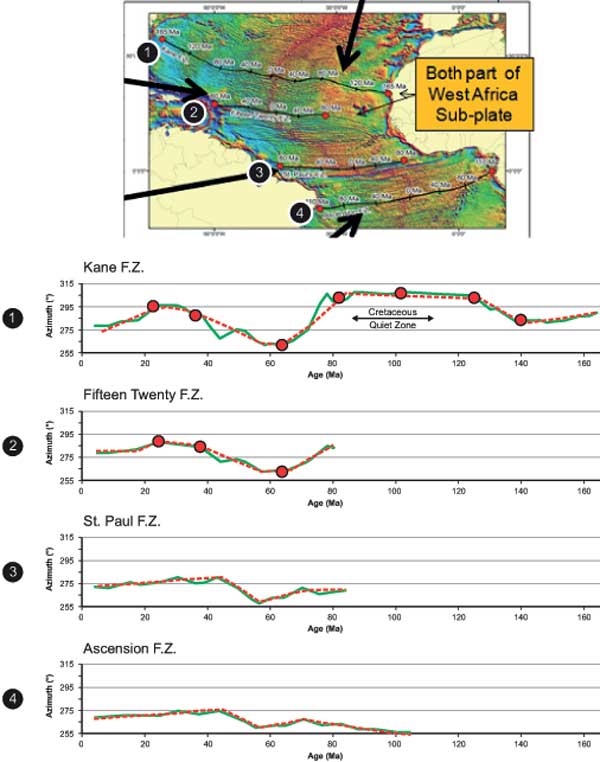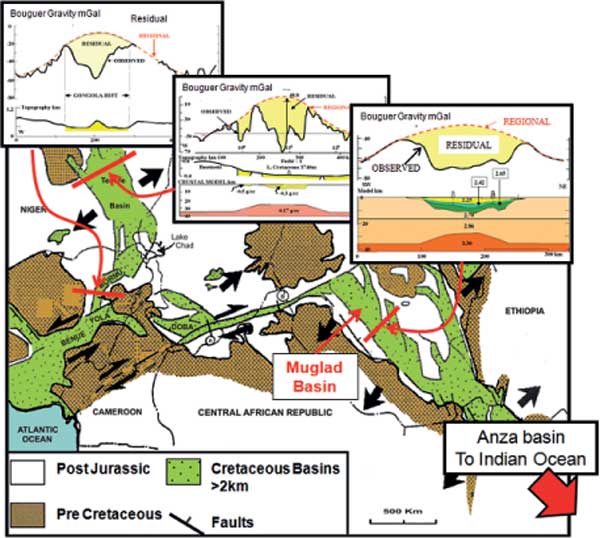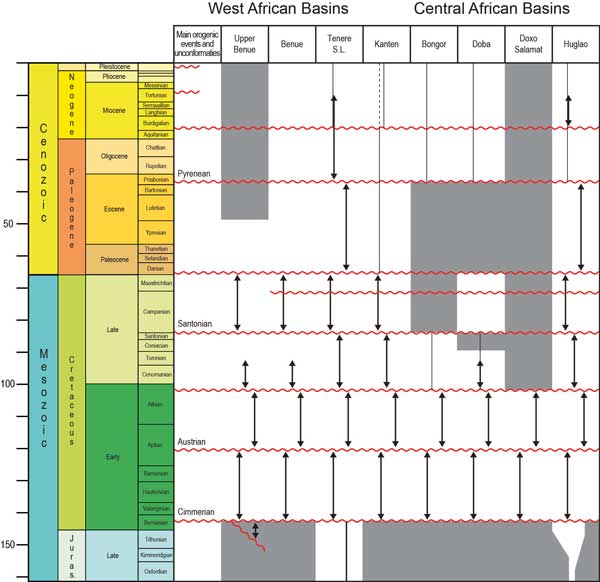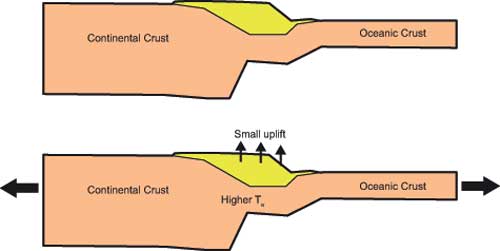 |
Plate Tectonics, Stress, and Unconformities: Evolution of the African Rift System and Atlantic Continental Margins |
J. Derek Fairhead1,2, C.M. Green1,2, S.M. Masterton1 and R. Guiraud1
1GETECH, Leeds, LS8 2LJ, UK, jdf@getech.com ; Sheona.Masterton@getech.com ; rg@getech.com
2School of Earth Environment, University of Leeds, Leeds, UK, cmg@getech.com
This webpage is a summary of: Fairhead, J.D., C.M. Green, S.M. Masterton, R. Guiraud, 2013, The role that plate tectonics, inferred stress changes and stratigraphic unconformities have on the evolution of the West and Central African Rift System and the Atlantic continental margins, Tectonophysics, 594, 118-127.
The Muglad rift basin of Sudan, is a good example of polyphase rifting, with at least three major phases of basin development. Each phase resulted in the generation of source rock, reservoir and seal geology with structural traps often closely linked to basement highs. Fairhead et al. (2013) investigate on a regional scale the tectonic processes that contributed to rift basin development.
On a regional scale, the evolution of the Africa-wide Mesozoic rift system is intimately linked to relative movements of African sub-plates and to global plate tectonic processes and plate interactions. Changes in plate interactions are observed in the oceanic crust as azimuth changes of fracture zone geometries (Figure 1). By inference, these have caused significant modifications to both the orientation and magnitude of the motions of the African sub-plates. Such plate motion processes have controlled the polyphase development of the West and Central African Rift System (Figure 2).

Figure 1: Azimuth change of fracture zones for the Central, Equatorial and South Atlantic. Click here or on Figure for enlargement.

Figure 2: West and Central African Rift system. Click here or on Figure for enlargement.
On the basinal scale, changes of sub-plate motions have resulted in changes in the stress field. These have had a clear impact on the deformation and fault geometries of rift basins and on the resulting stratigraphy. The unified stratigraphy of the West and Central African Rift System (Figure 3) shows close correlation in time between the major unconformities and relative plate motion as shown by changes in the azimuthal geometry of the oceanic fracture zones in the Central Atlantic (red dots, Figure 1). Since similarly timed unconformities exist along the continental margins of Africa and South America, we propose that the causative mechanism is change in relative plate motion, leading to increase or decrease in tension in the plate in the region of the continental margin. This controls the strength or effective elastic thickness, Te, of the crust/plate beneath the margins. In turn, this results in a focused change in isostatic response of the margin during short-period changes in relative plate motion, i.e. more tension will mean that loads are not compensated locally resulting in local uplift of the margin.

Figure 3: Unified stratigraphy chart for the West and Central African Rift System. Click here or on Figure for enlargement.
The continental margins thus comprise an effective weak zone within an evolving plate due to the sedimentary loading effect. Changes in plate stress, at times of plate motion change, are recorded in the form of sedimentary unconformities as the margin is isostatically uplifted or subsides. This study thus calls into question the idea that eustatic sea-level changes are the principal cause of the unconformities. Instead, it suggests that the principal cause is a plate-tectonic driven mechanism.

Figure 4: Continental margins act as weak zones to changes in plate stress
Bibliography of references for the West and Central African Rift Systems
-
Brown, S.E., Fairhead, J.D., 1983. Gravity study of the Central African rift system: a model of continental disruption. 1: the Ngaoundere and Abu Gabra rifts. Tectonophysics, 94, 187–203.
-
Fairhead, J.D., C.M. Green, S.M. Masterton, R. Guiraud, 2013, The role that plate tectonics, inferred stress changes and stratigraphic unconformities have on the evolution of the West and Central African Rift System and the Atlantic continental margins, Tectonophysics, 594, 118-127
-
Fairhead, J.D., Binks, R.M., 1991. Differential opening of the central and south Atlantic oceans and the opening of the Central African rift system. Tectonophysics, 187, 191–203.
-
Fairhead, J.D., Green, C.M., 1989. Controls on rifting in Africa and the regional tectonic model for the Nigeria and East Niger rift basins. Journal of African Earth Sciences, 8 (2/3/4), 231–249.
-
Fairhead, J.D., Mazur, S., Green, C.M., Masterton, S., Yousif, M.E., 2012b. Regional plate tectonic controls on the evolution of the West and Central African rift system, with a focus on the Muglad Rift Basin, Sudan. SAPEG. Journal Sudanese Association of Petroleum Geoscientists, (3), 14–29 (Feb 2012).
-
Watts, A.B., Fairhead, J.D., 1999. A process oriented approach to modelling the gravity signature of continental margins. SEG. The Leading Edge, 258–263 (February, 1999).
last updated 22nd
July, 2013 |
